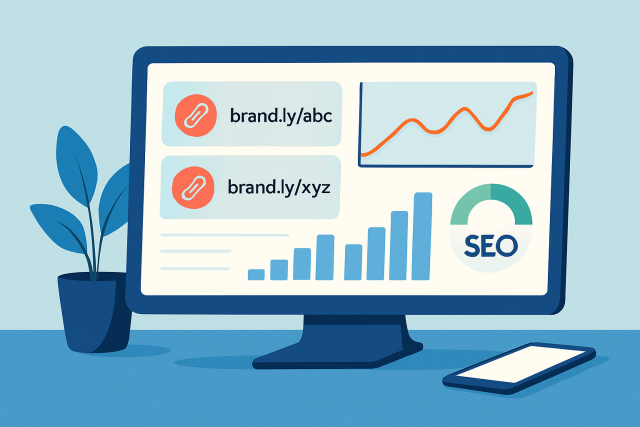How Vanity URL Structure Impacts Click Rates


Vanity URLs are nifty little web addresses that are short and customized. They are designed to be easy to remember and look clean. Instead of wrestling with long autogenerated URLs packed with mysterious numbers and baffling parameters, vanity URLs are crafted to match branding, keep things relevant, and stay simple.
Understanding Vanity URLs and How They Work (or Why They Matter More Than You Might Think)
A vanity URL is basically a short and snappy web address crafted to perfectly capture a brand, product or campaign — think of it as the digital equivalent of a catchy nickname. Instead of struggling with a clunky link like example.com/page?id=12345 a vanity URL is something much more user-friendly such as example.com/summer-sale. These links look cleaner and are easier to read, share and remember compared to default or autogenerated URLs that often include random characters or a jumble of query strings.
- Keeping URLs short and straightforward really helps users catch on to the link without scratching their heads.
- Including a branded domain or brand-related words makes the link more recognizable and a bit more trustworthy.
- URLs that are easy to remember give users the freedom to share or type them without breaking a sweat.
- Using human-readable characters cuts down on confusion and builds trust like a friendly nod in the digital world.
- Leaving out complex parameters avoids the dreaded spammy vibe or unnecessary clutter that no one wants to deal with.
Vanity URLs are a bit like those custom license plates on cars you see cruising down the street. Just like a personalized plate helps a vehicle stand out in a crowd and makes it easier to spot, a vanity URL gives your web address a distinct identity that people actually remember.
Why the Structure of Vanity URLs Can Really Make a Difference in Click Rates
URL structure plays a bigger role in user behavior than most give it credit for. A clean and relevant URL doesn’t just look good on paper—it builds trust and clears up any lurking doubts while gently nudging people to click. When individuals stumble upon a vanity URL there’s a subtle sense it’s been crafted with care, making it feel more reliable and deliberate.
- People naturally trust URLs that are straightforward and easy to understand.
- When URLs are simple and clear, it is easy to quickly scan and get the gist of the link.
- URLs that match what users are looking for build trust and set the right expectations.
- Shorter cleaner URLs put minds at ease and reduce worries about spam or phishing.
- Clear links look sharper and catch on faster, encouraging people to share them widely on social platforms.
A thoughtfully crafted vanity URL often feels like a confident digital handshake—warm, welcoming, and just a bit reassuring. It reflects professionalism in a way that quietly says, "I’ve got this," and nudges users to engage without any fuss or hassle.
Essential Components of Effective Vanity URL Structures That Actually Work
Creating a good vanity URL is about striking the right balance between clarity and relevance while keeping things short and sweet. Tossing in your main keywords and brand name makes the URL catchier for users and boosts its search value. It’s a good idea to steer clear of extra punctuation or weird special characters—trust me, simplicity here saves you from headaches and typos down the road.
Use keywords that really line up with the page or campaign because this helps keep things crystal clear and gives your SEO a little extra muscle.
Keep the wording straightforward and snappy so individuals can easily scan it and actually remember what they saw.
Steer clear of special characters and underscores since they tend to trip people up or mess with links more often than you would think.
Whenever possible, include the brand name or something familiar as a simple way to build that all-important trust.
Use hyphens instead of underscores to separate words because this little tweak makes the whole thing way easier on the eyes.
| URL Type | Example URL | Length (characters) | Memorability | Perceived Trust |
|---|---|---|---|---|
| Vanity URL | example.com/summer-sale | 22 | High | High (straightforward and really on brand) |
| Non-Vanity URL | example.com/page?id=982394823 | 33 | Low | Lower (kind of a headache with all those parameters) |
| Vanity URL | brand.com/discount2024 | 22 | Medium-High | High (clean and totally focused on the brand) |
| Non-Vanity URL | brand.com/products?cat=12&page=3 | 39 | Low | Lower (feels a bit autogenerated and impersonal) |

Visual comparison highlighting the distinctions between vanity URLs and non-vanity autogenerated URLs.
Key Technical SEO Points to Keep in Mind for Vanity URLs the Little Details That Make a Big Difference
Vanity URLs tend to grab the spotlight for both users and search engines alike. When URLs are clear and filled with relevant keywords they make it easier for crawlers to understand the page’s context. This can boost indexing and relevance signals. It’s vital to manage these URLs properly to avoid headaches like duplicate content issues.
- Keep URLs short to make life easier for crawlers and ensure they show up neatly in search results. Brevity really is the soul of the URL here.
- Sprinkle in relevant keywords within your URLs to give search engines a clear heads-up about what your page is all about.
- Stick to the same vanity URLs across your site to avoid any duplicate content headaches because consistency is key, as I have learned the hard way.
- Always use HTTPS for your URLs. It not only boosts security but also nudges your search rankings in the right direction.
- When necessary, use canonical tags to point search engines to your preferred URLs and keep indexing issues at bay.
Vanity URLs don’t directly boost your search rankings, but they do work behind the scenes by making the user experience smoother and encouraging more clicks—both of which are handy signals for search engines. It’s a bit of a common myth that simply tweaking your URLs will magically shoot your rankings up overnight.
Case Studies That Really Show How Vanity URLs Can Give Click Rates a Nice Little Boost
Many businesses have noticed a pretty solid bump in their click rates after making the switch to vanity URL structures. These examples really show how a well-crafted URL design can not only grab user attention but also stick in their minds, boosting brand recall and racking up more social shares.
| Company | URL Before | URL After | Click Rate Increase | Key Notes on Implementation |
|---|---|---|---|---|
| TrendShop | trendshop.com/product?id=98765 | trendshop.com/new-arrivals | 35% | Trimmed down the URL so it vibes better with the campaign and branding—makes it catchier and easier to remember |
| FreshEats | fresheats.com/menu?cat=12&page=5 | fresheats.com/vegan-options | 28% | Zeroed in on a clear, specific category which seemed to build more trust with users—less clutter, more clarity |
| TechPulse | techpulse.com/article?id=1234 | techpulse.com/ai-future | 42% | Tossed in some targeted keywords that really matched what people were searching for, helping clicks to jump up |
| UrbanWear | urbanwear.com/shop?item=452389 | urbanwear.com/sale | 30% | Simplified the URL nicely, which seemed to give social sharing a little extra oomph |
These case studies highlight how thoughtfully crafted vanity URLs genuinely boost user engagement by making links clearer and easier to share. The main takeaways are simple: match your URLs to the content’s goal, keep things straightforward, and add your branding where it fits naturally. Tools like Moz Pro and Mangools often help marketers find relevant keywords and track URL performance.
Handy Tips for Creating and Testing Vanity URLs That Actually Work (Because We All Hate Broken Links)
Creating effective vanity URLs requires a bit of careful planning and some regular fine-tuning. Tools that analyze keyword performance and give you a sneak peek of how URLs appear in search results can be a real lifesaver when it comes to spotting little tweaks that pack a punch. Running A/B tests on different vanity URLs during your marketing campaigns often reveals which ones are really pulling their weight in clicks and engagement.
Dream up short URL strings that pack your target keywords and clearly tie back to the linked content with no fluff just the good stuff.
Lean on URL shorteners or builder tools that let you add your own spin and give your links a polished branded vibe.
Sneak in your brand name or little unique touches to make your identity stick like glue whenever it’s possible.
Put your vanity URLs through their paces across various marketing channels like email, social media and ads. See which ones truly get the clicks rolling in.
Keep a close watch on your analytics like a hawk so you can spot patterns and keep fine-tuning those URL strategies over time.
Frequently Asked Questions
How do vanity URLs improve click rates compared to standard URLs?
Vanity URLs boost click rates by being shorter and easier to remember. They look trustworthy and relevant, unlike long messy URLs with random parameters. Clear branded URLs are the kind people want to share and remember, which helps increase engagement.
Can vanity URLs negatively impact SEO if not implemented correctly?
Absolutely, if you create duplicate URLs or use inconsistent formats it can confuse search engines and hurt your SEO. Always use canonical tags for duplicates, stick to HTTPS and avoid unusual characters. When done right, vanity URLs improve user experience and increase click-through rates.
What tools can help create and test effective vanity URLs?
There are handy tools like Moz Pro, Mangools, and URL shorteners such as Bitly and Rebrandly that help with keyword research, URL customization, and performance tracking. A/B testing tools like Google Optimize let you compare different URLs to see which gets more clicks. Analytics platforms such as Google Analytics monitor engagement trends over time.
How long should a vanity URL ideally be?
Aim to keep it under 60 characters which is short enough to glance at quickly while still including important keywords or branding. For example, `example.com/summer-sale` is more effective than `example.com/sale-2024-07-discount-code-50-off`. The key is striking the right balance between snappy and clear.
Are vanity URLs worth the effort for small businesses?
Definitely yes. Small businesses benefit from higher click rates, better brand recall and increased trustworthiness. Start with your highest-traffic pages like the homepage or special promotions and expand from there. With many free tools available, it’s affordable and the engagement boost usually pays for itself.
Should I include dates or campaign codes in vanity URLs?
Generally avoid dates or campaign codes unless necessary since they clutter URLs and make them less evergreen. Instead, use timeless terms like `example.com/spring-collection`. For campaigns, short clear URLs such as `example.com/holiday-deals` work well. You can track details separately with UTM parameters.
Unlock Digital Marketing Success with Moz
Struggling to optimize your online presence? Moz is the ultimate Internet Marketing solution, empowering businesses with powerful SEO tools, insightful analytics, and expert guidance. Elevate your digital strategies and outshine the competition.
- Boost organic traffic with data-driven SEO tactics
- Enhance content marketing with expert recommendations
- Gain a competitive edge with comprehensive link analysis








